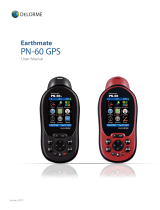
Getting Started
Thank you for purchasing the DeLorme Earthmate GPS PN-20. This versatile and compact GPS
receiver lets you create tracks of your travels, create routes so you never get lost, find points of interest,
and more!
This manual provides instructions for using all of the functionality available on the Earthmate GPS
PN-20. Most of the chapters are based on “Pages” which are the main screens on the device. Each
chapter describes the features of that particular Page as well as the Menu options which are avail-
able from that Page. In addition, this manual also discusses basic functions (such as map panning,
battery information, map data information, and more) as well as frequently asked questions, warranty
information, etc.
Step 1 — Installing the Batteries
The Earthmate GPS PN-20 is a battery-powered device. It can be powered by one rechargeable
Lithium-ion battery or two AA batteries (NiCd, NiMH, alkaline, or lithium).
To install the batteries, unscrew the D-Rings on the back of the Earthmate GPS PN-20 until the
battery cover is able to be removed. Then, insert the batteries according to the polarity symbols
found inside of the battery compartment. When finished, position the battery cover back on the
Earthmate GPS PN-20 and re-screw the D-Rings into the Earthmate GPS PN-20.
Step 2 — Turning On the Earthmate GPS PN-20
The Power button is located at the bottom-right corner of the button area. To turn on the Earthmate
GPS PN-20, press and hold the Power button for 1.5 seconds. The first Page that displays on the
screen when you turn on the Earthmate GPS PN-20 is the Satellites Page. Your GPS status displays in
the upper-left corner of the Satellites Page. If you press the PAGE button, the Map Page will display
on the screen. The map will not center on your current location until you have achieved a 2-D or 3-D
fix. The default view when a GPS fix cannot be obtained is your last GPS position.
If it is taking a long time for the device to obtain a 2-D or 3-D fix, verify it has a clear view of the sky.
Be sure that trees, buildings, and other obstacles are not blocking the Earthmate GPS PN-20. If the
device still cannot obtain a 2-D or 3-D fix, press the QUIT button to return to the Satellites Page, press
the MENU button, highlight the Set Current Location option, and then press ENTER. The Map Page
displays automatically. Pan the map to your current location and press ENTER.
To turn off the Earthmate GPS PN-20, press the Power button and then press the ENTER button to
confirm you want to turn the Earthmate GPS PN-20 off.
Step 3 — Using the Buttons on the Earthmate GPS PN-20
The buttons on the Earthmate GPS PN-20 provide you with access to all of the functionality on the
device. Each button has a unique purpose:
In/Out
The IN and OUT button lets you zoom in or zoom out on the map.
• Press the IN (left) side of the button once to zoom the map in one level (showing more detail).
• Press and hold the IN side of the button to zoom the map in to its maximum level.
• Press the OUT (right) side of the button once to zoom the map out one level (showing less detail).
• Press and hold the OUT side of the button to zoom the map out to its maximum level.
Page
The PAGE button lets you scroll through all of the enabled “Pages” on the Earthmate GPS PN-20.
The default Page button sequence is:
• Satellites
• Map
• Compass
• Trip Info
• Route Directions (available when navigating)
For an overview of what you can view and do on each Page as well as each Page’s Menu functions,
see Appendix A on page 65.
Menu
The MENU button provides access to a multitude of functionality. The Menu is divided into top and
bottom sections which are separated by a line. The items in the top section are specific to the Page
that is currently active. The items in the bottom section are standard menu options which are avail-
able from any Page.
Tip: You can add, remove, or
reorder the Pages that dis-
play when the Page button
is pressed using the Device
Setup/Page Order settings. For
more information, see the To
Modify the Page Order Set-
tings section on page 61.
Getting Started
Tips:
• Setting the correct battery
type will optimize the bat-
tery’s performance. For more
information on selecting bat-
tery type, see To Modify the
System Settings on page 59.
• Because the Earthmate GPS
PN-20 has a real-time clock
which requires power even
when the device is powered
off, your batteries are con-
stantly in use. If you use your
Earthmate GPS PN-20 spo-
radically (e.g., more than a
month between uses), it is
suggested that you remove
the batteries for long-term
storage and then reinsert
them when you want to use
the device.
Tip: If the Earthmate GPS PN-
20 does not turn on, ensure
that the batteries are inserted
into the device properly and
that they are mostly or fully
charged.





















